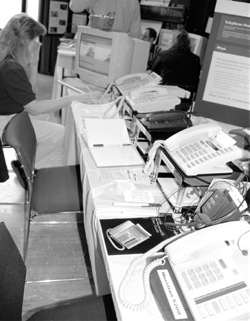By Rebecca A. Doyle

The Information Technology Division’s IT Communication Services (ITCom) technology fair had something to offer everyone, from ways to use your voice mail options more effectively to an explanation of the different methods that are available to telecommuters who need to access information at the U-M. The fair was held last week in the Alumni Center as part of an overall effort to make members of the campus community aware of their options for sending and receiving information of all types.
In addition to workshops, the Alumni Center bristled with cabled and cable-free technology displays. In one corner, wireless communication from a number of platforms was demonstrated, while in another, a large plywood closet showed computer users—who may only have been familiar with monitors and keyboards—what goes on behind the closed doors of the computer closets.
Although occasionally geared to those with a more technical background, most presentations and displays gave U-M faculty, staff and students a good idea of what products and services are available to them, or soon will be.
Telecommuting
Katie D. Vawters, IT Communications project manager, usually works from her home near Belleville. As an experienced telecommuter, she was well suited to the job of telling others what the options were for communications and data transmission from home to office.
Having the technology at home has made a difference in how she works, Vawters says. “I find myself spending more time working than I did—it’s so easy to say, when it is 5 p.m., ‘Oh, I’ll just finish up this one project before I quit.’” Vawters handed out a list of the available data network connections for residents, complete with prices and pointers to resources for more information.
“As long as it has been approved that you work at home, we’re very happy to help people get set up for telecommuting.”
Andy Palms, ITD director of product development, outlined the differences between ASDL (asynchronous digital subscriber line), ISDN (integrated services digital network), cable modem and dial-in modem connections for both departments and individuals who are in off-campus work sites. ASDL, he noted, is still only available in limited areas in Ann Arbor.
Internet2
Jeff Ogden, ITD associate director for the Merit Network, asked his audience what Internet2 was and how they would use it. Replies from those in physics, community learning, fine arts and nursing showed a variety of hopes for the “faster, bigger, better” connection that Internet2 provides to university communities.
“The goal of Internet2,” Ogden said, “is to make possible applications that aren’t possible yet.” He cited collaborations in astronomy that would allow remote control of telescopes; the Visible Human Project that requires transmission of high-quality, three-dimensional graphic images; performances and interactive master classes in fine arts that are conducted from across the nation; and capabilities to transmit much larger data streams than is possible on the current internet.
“Internet2 is still experimental,” Ogden said. “Not everybody is connected. We are, MIT and Stanford are. Commercial groups are not—banks are not. But the goal is to migrate the technology to the commercial Internet so that they will be.” In the meantime, he said, those who now have access to Internet2 have the advantage of high-speed, high-quality connection with relatively little competition.
Voice Mail
In “U-M Voice Mail: Using it More Effectively,” Catherine Lilly, ITCom customer services manager, gave a crash course to those who use voice mail on the University telephone system. Quick tips and hints for managing voice messages gave everyone who attended something new to take back to the office.
An especially useful feature Lilly highlighted was the option to record a temporary greeting that can be set to expire at a given time and date. Once in your mailbox on the Meridian system, press 82, then 3 to select temporary greeting. Record your temporary greeting, press #, then press 9 and follow the prompts to set the date and time it will expire. Remember to press 83 after accessing your mailbox to log out of the system.
“This does help eliminate those messages you get from people who say, ‘By the way, your voice mail says you’re still on vacation,’” Lilly noted.
Lilly’s presentation was one of eight available to attendees.

